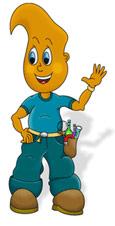
Globule wonders...
How can we heat a balloon without popping it?
Experiment: Heat
Hypotheses: Ask children what would happen if we were to heat a balloon over an open flame. Would it pop? Why? If we fill the balloon with water, would the results be different? What sound do we hear when a balloon pops?
Material:
- A steady candle
- A cigarette lighter or matches (manipulated only by your daycare worker!)
- A few balloons
- Water
Manipulations:
DANGER! Because this experiment involves fire, the manipulations must be done by your daycare worker. Make sure you are standing away from the flame at all times!
- Your daycare worker places the steady candle a safe distance away from the group. You must remain seated and calm. This is an excellent occasion to talk about the danger which surrounds fire.
- Your daycare worker blows up a balloon and questions you as to how long you think she can move it over the flame before it pops.
- She places it over the flame. The group counts 1, 2, 3, 4, 5, 6...pow!
- Next, your daycare worker adds water to another balloon by securing it over a faucet.
- She blows up this balloon, making sure there is at least 1cm of water in the bottom of the balloon once it is blown up. If there is not enough, she must start over.
- Again, she questions you as to how long she will be able to move the balloon over the flame before it pops.
- The daycare worker can move the balloon freely over the flame while children count. The balloon will not pop! Still, do not leave it over the flame too long, unless you want a shower!
Explanations: Heat transfers from one object to another through conduction. Some objects conduct heat well while others do not. For example, if you fill a glass with very hot water, you will feel the heat on your hand. On the other hand, if you fill a Styrofoam glass with very hot water, it will not be as hot on your hand. You don't believe me? Try it! This is easily explained by the fact that glass is a good conductor and Styrofoam is a poor conductor. The heat remains in the water. It is not transferred to the Styrofoam.
In our experiment, rubber was a poor conductor. Therefore, the heat could not transfer to the balloon. The heat from the flame remained on the small area directly exposed to the heat. The rubber melted at this spot and caused the balloon to pop. When there was water in the balloon, the heat spread through the water, a good conductor. The balloon could be exposed to the flame as long as there was water in it.
Try to find other objects in your environment which are good conductors and others which are poor conductors.
Angélique Boissonneault
has a Bachelor's Degree in Biological Science. She has worked in a laboratory and tested her knowledge. She has taught Math, Chemistry, and Physics. She has also developed a simplistic and innovative approach designed to introduce young children to scientific experiments, old and new. She created her friend Globule. This character is sometimes red, and sometimes white. He guides little ones through their scientific experiments and discoveries. It is clear to see Angélique is passionate about children and science. Globule's Approach.

 Home
Home Theme activities
Theme activities
 Babies and toddlers
Babies and toddlers
 Arts and crafts
Arts and crafts
 Science
Science
 Creative recipes
Creative recipes
 Tips and tricks
Tips and tricks
 Special needs
Special needs
 Extra activities
Extra activities
 Educ-TV
Educ-TV
 Newsletter
Newsletter  Online store
Online store Educatall club
Educatall club


